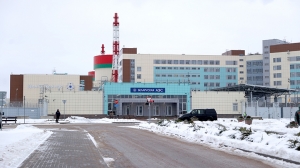Belarusian nuclear power plant expected to bolster Union State energy security

MINSK, 7 March (BelTA) – The Belarusian nuclear power plant will allow bolstering energy security of the Union State of Belarus and Russia, BelTA learned from Vasily Panasyuk, Deputy Chairman of the Industry, Fuel and Energy Complex, Transport and Communications Commission of the House of Representatives of the National Assembly of Belarus.
Vasily Panasyuk said: “Synchronous operation of the Belarusian power grid and the Russian one will noticeably increase the level of both energy security and economic security in the Union State of Belarus and Russia. The formation of the joint electricity market is the most important step in achieving economic sovereignty of the two countries. The common market will allow protecting electricity consumers from any external impacts. While interacting with Russia, we will always be able to lend a shoulder to each other.”
The MP also reminded that via the joint electricity market Belarus will be able to sell electricity to Russia and countries of the Eurasian Economic Union. “Within the framework of the common market of the Union State of Belarus and Russia a unified tariff policy will be worked out for energy industry products. In turn, it will allow creating more flexible prices for electricity for consumers,” he said.
Vasily Panasyuk stressed that the Belarusian nuclear power plant is an economically profitable project. In his words, the nuclear power plant will allow substituting over a quarter of the natural gas the country consumes while carbon dioxide emissions will be reduced by more than 7 million tonnes per annum once the nuclear power plant is fully operational.
The Belarusian MP went on saying: “Once the nuclear power plant operates at its full capacity of 2,400MW, its annual electricity output will exceed 18 billion kilowatt-hours (kWh), which will satisfy about 50% of the domestic demand. We will also diversify the kinds of fossil fuels used for electricity generation. In addition, ecological problems will be addressed. Once the nuclear power plant is fully operational, greenhouse gas emissions will be reduced considerably. And most importantly, the need to buy natural gas will be substantially decreased, thus saving Belarus a lot of money.”
During the government conference hosted by Belarus President Aleksandr Lukashenko on 7 March to discuss the operation of the Belarusian nuclear power plant it was noted that the second unit of the nuclear power plant will begin commercial operation in October 2023. Its first test connection to the national power grid is scheduled for April. Since it was connected to the power grid, the first unit of the Belarusian nuclear power plant has generated over 12.5 billion kWh of electricity. It allowed substituting over 3 billion m3 of natural gas and saving over $400 million for the country.
The Belarusian nuclear power plant uses the Russian design AES-2006 featuring two VVER-1200 reactors with the total output capacity of 2,400MW. It is an evolutionary nuclear power plant design with third-generation water-moderated reactors with enhanced safety. They boast improved technical and economic parameters. A unique combination of active and passive safeguards is their key feature. The building housing the reactor is covered by a double protective shell. The reactor can survive an earthquake, a hurricane, and flooding.
The VVER technology is by far the most demanded and tested in the world. The technology was used to commission nuclear power plants in China and India over the course of the last ten years and will be used to commission nuclear power plants in Egypt, Türkiye, Hungary, Bangladesh, and Uzbekistan.













